It’s a Big Blade that’s Good for Cooking and Okay at Most Everything Else at the Campsite
Key Takeaways:
- Good for cutting up meat and vegetables;
- It’s great for rough chopping vegetables and slicing meat;
- The knife is built well enough to handle hard-use tasks other than food (chopping, batoning, etc)
- The handle is good as long as you’re cutting food, but it feels harsh for some survival and bushcraft tasks.
- The blade is okay at making feather sticks and chopping wood,
- The jimping on the spine is too aggressive for any kind of comfort, but it’s great at throwing spark off a ferro rod.
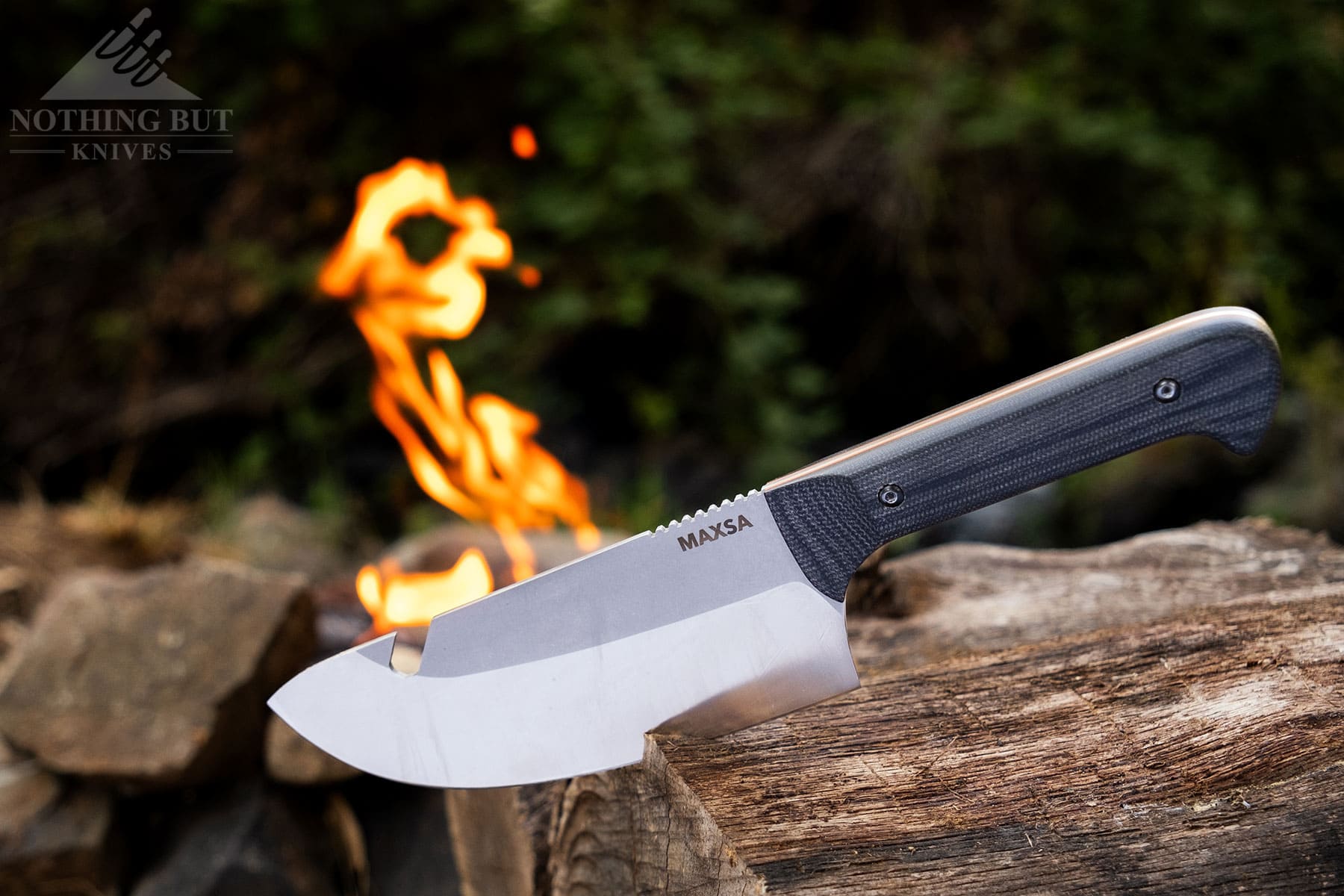
There’s nothing quite like a big, bone-cracking, cleaver-esque knife with a gut hook for campfire cooking.
That’s mostly all I wanted to do with this Maxsa Blade, but Maxsa themselves tout this thing as the “perfect all-purpose knife” that’s “strong enough to easily chop, carve, skin, gut, slice and cut anything, anywhere.”
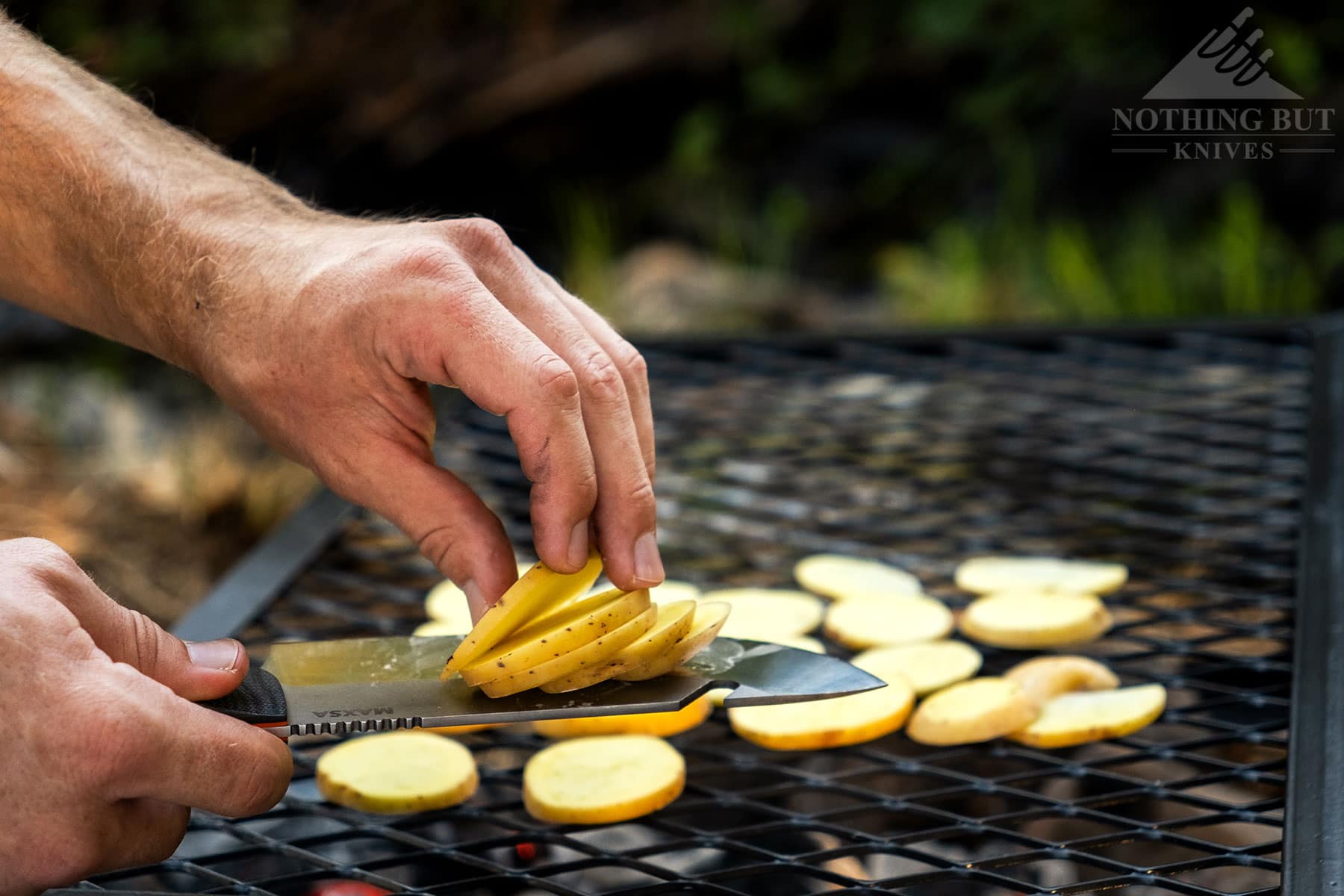
I’m not sure how many people would want to skin or gut with this knife, but they’re not far off on the chopping and carving thing. I wish they had put more effort into the sheath, but that’s par for the course with fixed blades, especially in this size category.
Taken in as a whole, it actually is a decent camp cooking knife that you could use for some rough bushcraft and survival work.
Specifications
| Overall Length: | 11.8” |
| Blade Length: | 6.5” |
| Blade Steel: | AUS-10 (58 HRc) |
| Blade Thickness: | 0.12” |
| Blade Shape: | Standard |
| Blade Grind: | High flat |
| Handle Length: | 5.3” |
| Handle Material: | MIcarta w/ G10 liner |
| Sheath: | Kydex sheath |
| Weight: | 10.8 oz |
| What I Liked | What I Didn’t Like |
|---|---|
| Overall great for cooking at a grill or campfire | Kitchen-knife style handle feels harsh for some campsite tasks |
| The blade holds up to hard use and has a good bite | The sheath is a bare-minimum design |
| Sloped bolster is a nice and uncommon touch in outdoor cooking | The spine jimping is way too aggressive (it’s good with a fire steel, though) |
| The gut hook: works for grills, works for beers |
The Handle: Good in a Pinch but Hard on the Swing
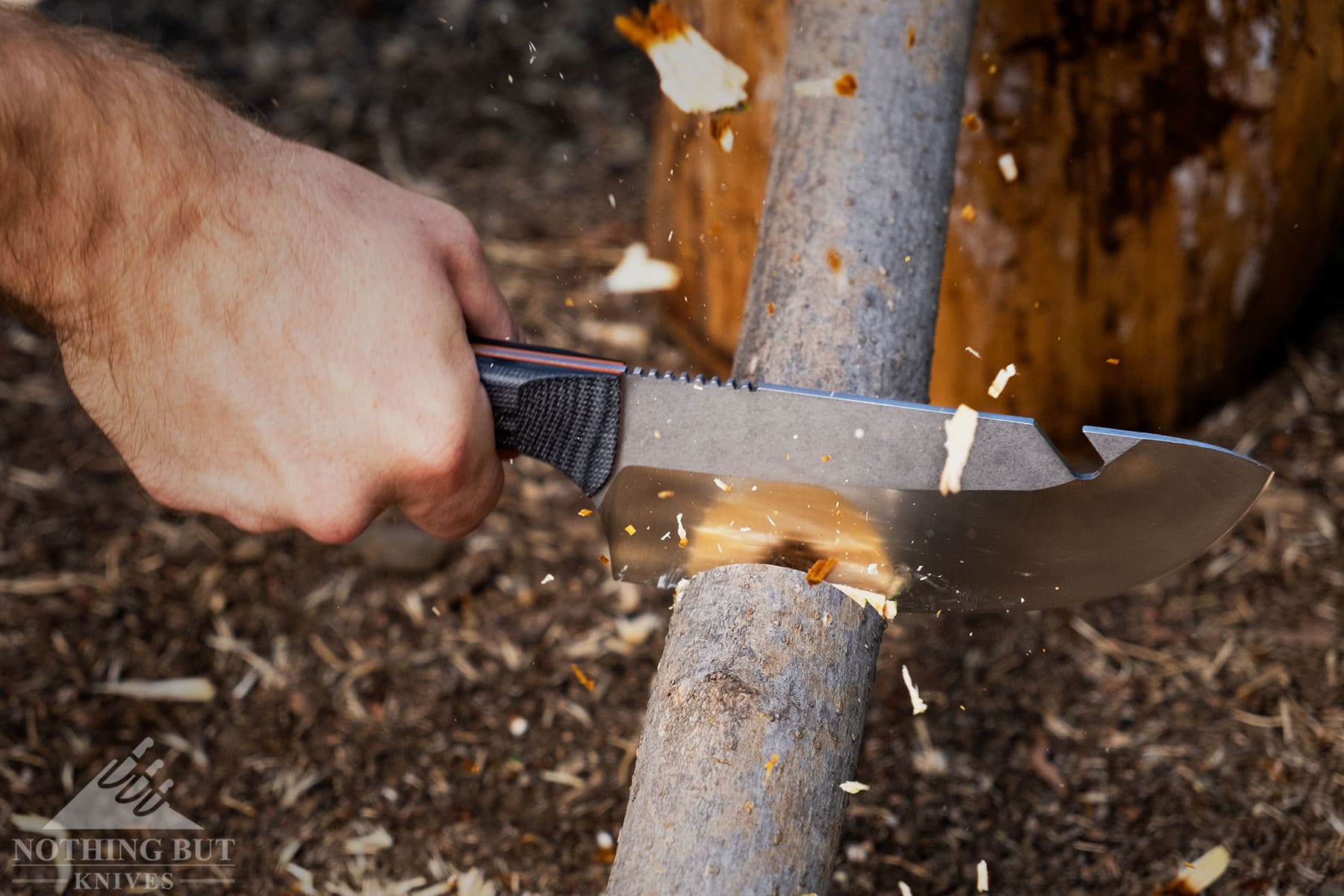
Here are the highlights:
- The sloped bolster works well for pinch grips;
- It has Micarta scales, but they have a smooth, hard polish on them;
- The squared handle shape and the sloped bolster are nice for food prep;
- The handle feels a lot harsher for high impact tasks like chopping, or long, straining tasks like making tinder;
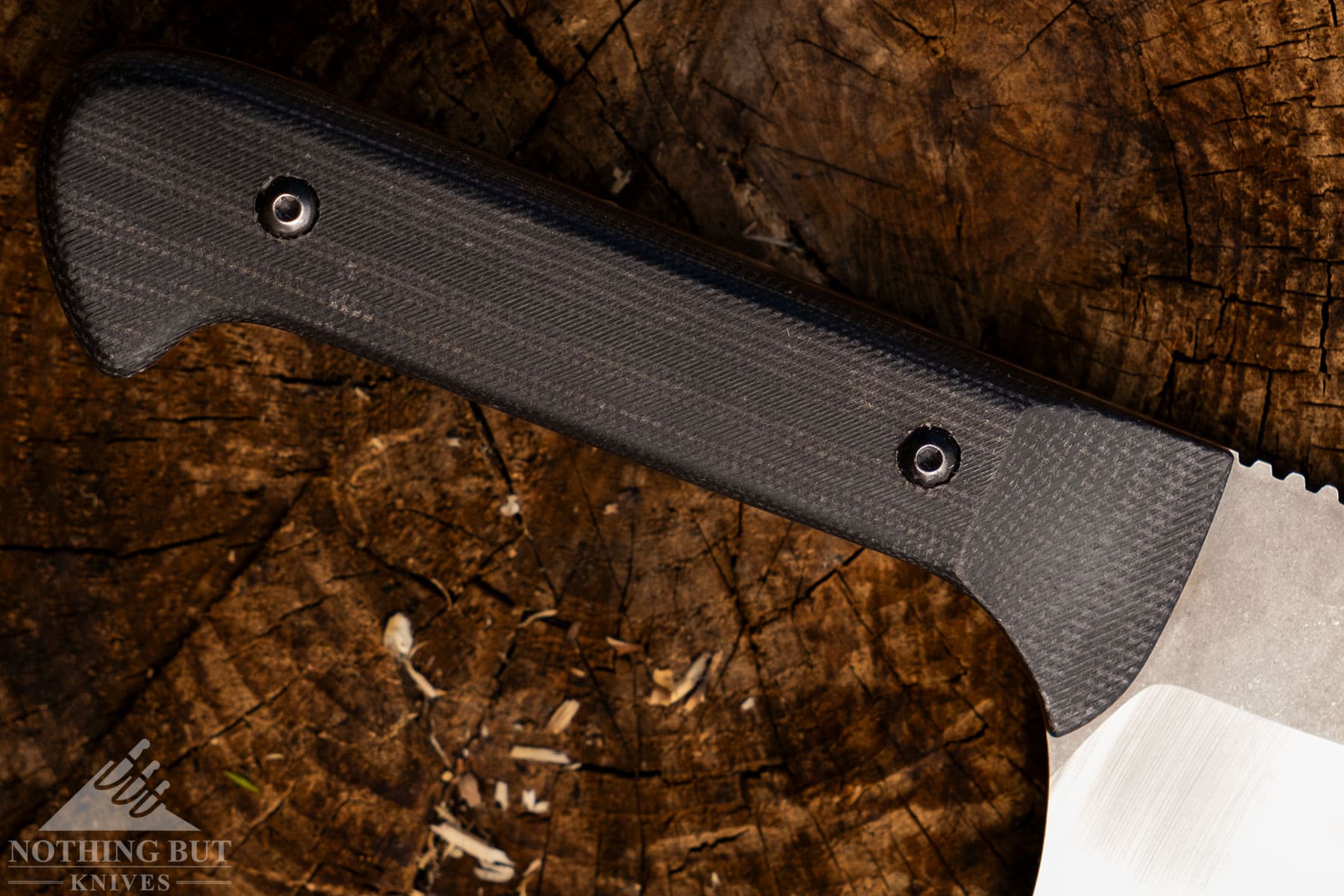
I have to give them props for putting a sloped bolster on this. That and the high grind are what really make this an okay food prep knife.
It’s also surprisingly not bad for chopping thanks to the way they shaped the pommel. I have no fear of momentum or keeping the knife in hand when I’m swinging hard on a hot day.
The handle doesn’t stay comfortable, though. It’s more kitchen knife handle than outdoor knife handle, so it jars my hand pretty bad after a bit, and starts to bite into my hand after a few minutes of making a feather stick. It’s usable for both tasks, but it’s not’s ideal.
The Blade and Steel

The Highlights:
- The blade has a good bite that chops well so long as the wood is dry enough, otherwise it bites too hard into the wood;
- It cuts meat beautifully, and feels pretty good for rough chopping vegetables;
- The AUS10 steel is holding up: the edge bends before it breaks, and it’s been pretty painless to maintain and straighten out.
I was both intrigued and conecerned when I saw what kind of steel they were using with this thing.
I like AUS10. Cold Steel and Spyderco have done some great things with it. For a stainless steel it has a pretty high carbon content, which can mean that it has really high edge retention, among other things.
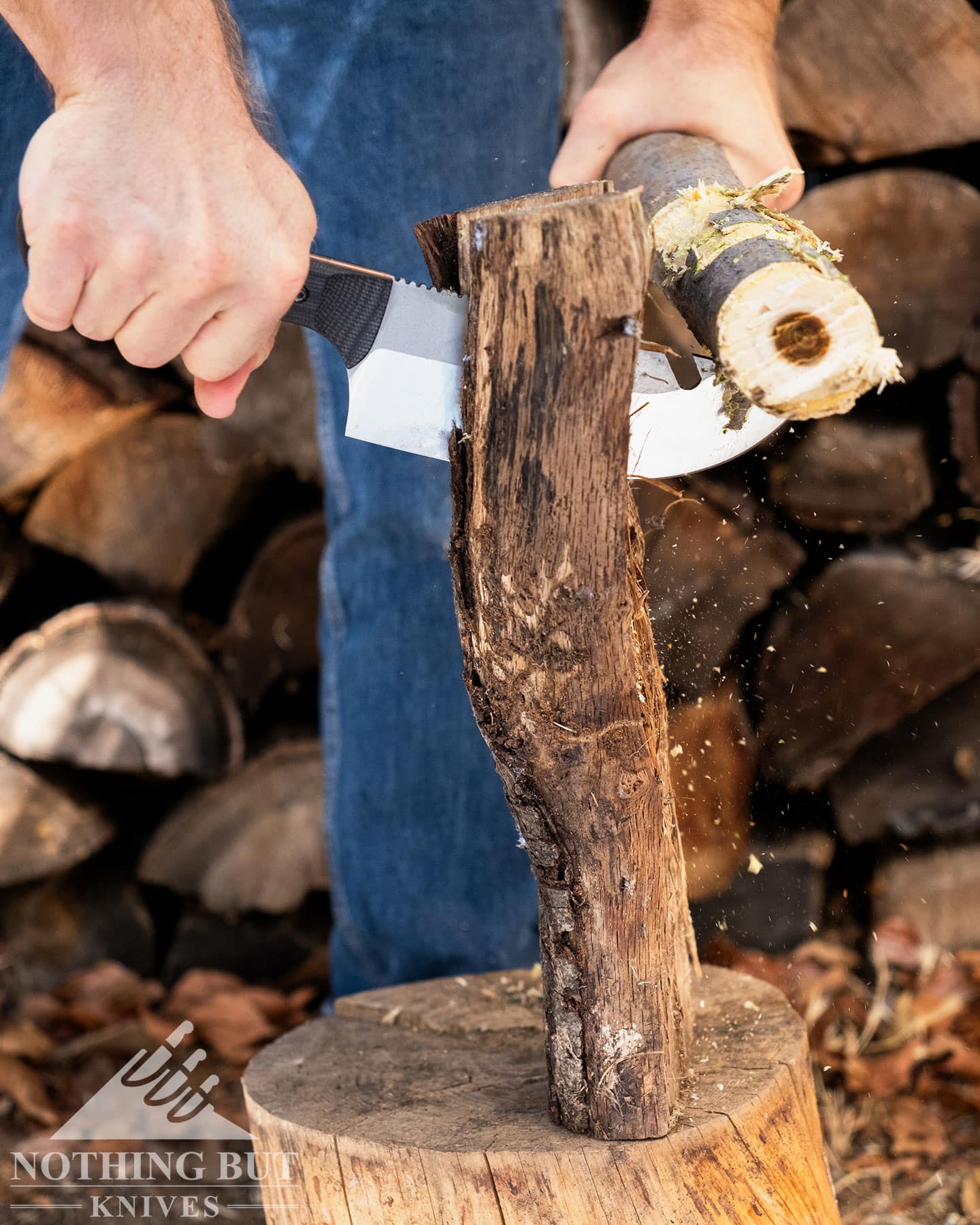
But if it isn’t heat treated right it can be an ugly, chippy mess. I’ve handled Cold Steel knives enough to trust them with it, but who the hell are these Maxsa guys? I don’t even know what factory they’re using.
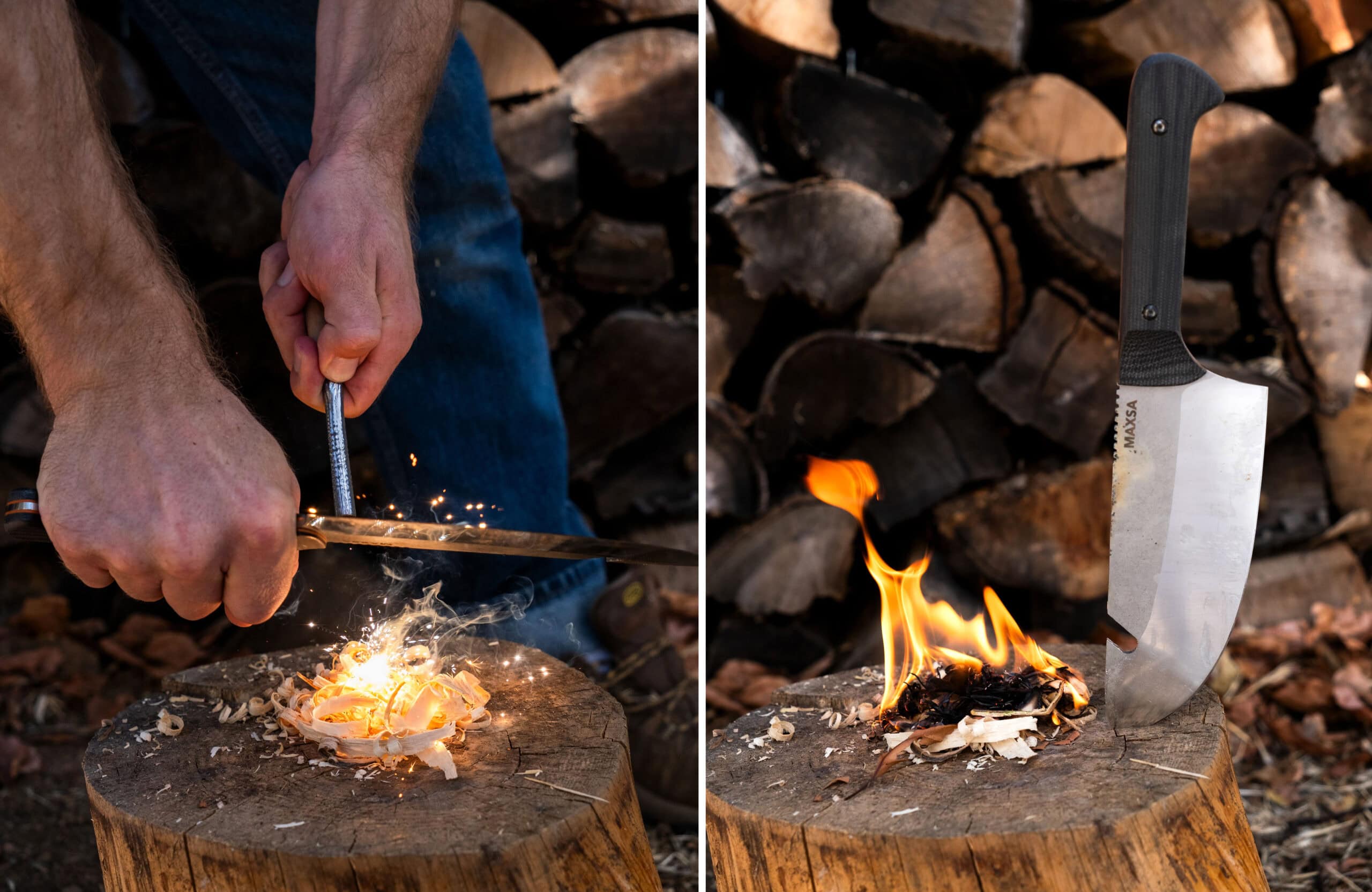
Their product description is kind enough to give you impressive sounding particulars like having “3x more carbon and 38% more chromium”, which sounds great and all, except they don’t specify more than what.
But I worry too much.
I chopped, batoned, and carved with this knife and the blade came out the other end looking fine. It bends before it breaks, which is what I want most of the time outdoors. The edge does roll and dull a little quicker than I’d like, but it feels like they’ve opted to make it easy to sharpen and maintain, which is just fine in this context.
In Use

As long as I’m working with food, I really liked the Maxsa blade. It got a little more complicated when I took it to other campground tasks, though, mostly thanks to the handle and the jimping, but here’s the quick run down.
- It cuts meat like butter, and it’s nice for rough chopping vegetables.
- When I tried finer cuts like julienne and dicing it didn’t go so well. It’s hard to get cuts to stay straight when cutting through larger foods, so things started to look a little janky as I tried to cut smaller. The blade would need to be a full flat grind to really take off in the kitchen (but that’s not where it’s meant to be, so forward we go).
- The edge has a good bite, which can be nice for chopping and carving wood. It carves feathers with pine pretty well, and it’s great for chopping dry wood.
- The handle bites pretty bad while making a feather stick, so even though the blade was handling the wood okay, it was less than pleasant to make enough tinder for a fire.
- The jimping is harsh. And I find it more harmful than helpful since I don’t generally use this knife for finer carving. I don’t need my thumb on the spine that much. And even if I did, I wouldn’t need something as pronounced as the spikes they’ve ground into this thing.
- It’s great at throwing spark off a ferro rod thanks to the jimping, though. It’s so aggressive that once you break a fire steel in it starts throwing big sparks pretty easily.
- It’s not ideal for batoning. The spine is thick enough, but the edge geometry just doesn’t seem to want to crack the wood. I wouldn’t want to tackle anything harder that a half round of pine with this.
Comparison and Alternatives
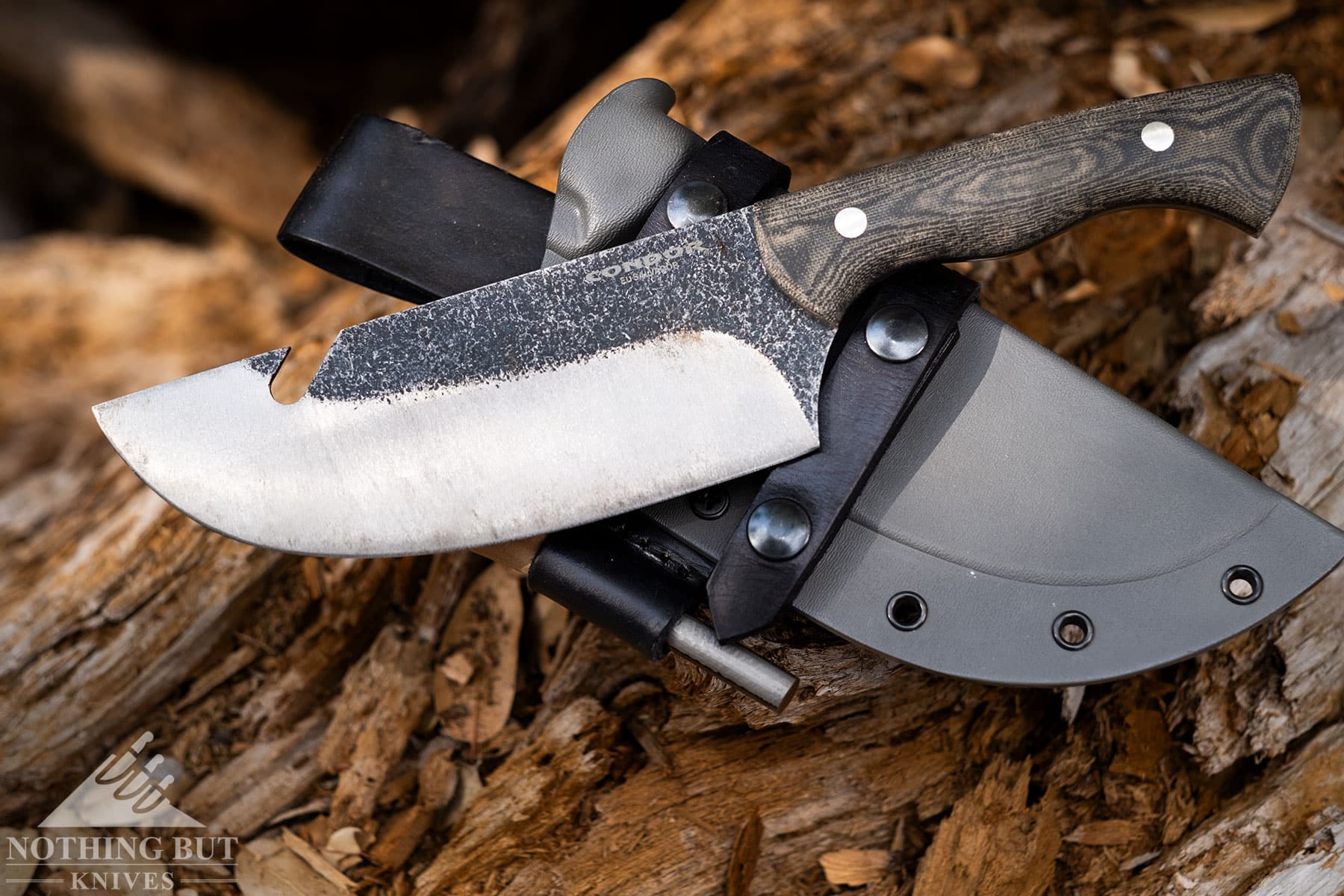
These days there are plenty of options for camp cooking knives, but the blade shape on the Maxsa Blade does put it into a somewhat specific category.
The Condor Bush Slicer offers the same range of uses just with a non-stainless steel in a convex grind. More importantly, it’s the better-sheath option.
The Kitchen Perfection chef’s knife, weird as it is for me to recommend it, is pretty similar in size, shape, and spirit. The handle is a lot more comfortable and the edge feels more or less the same in action, but whatever steel they’re using in that thing is softer and takes on stains and rust a lot quicker.
Finally the Off Grid Grizzly V2 is an outdoor camping knife with a good sheath (not as good as the Bush Slicer) and an incredible blade with an edge that can actually keep up with my kitchen knives at home.
Closing Thoughts
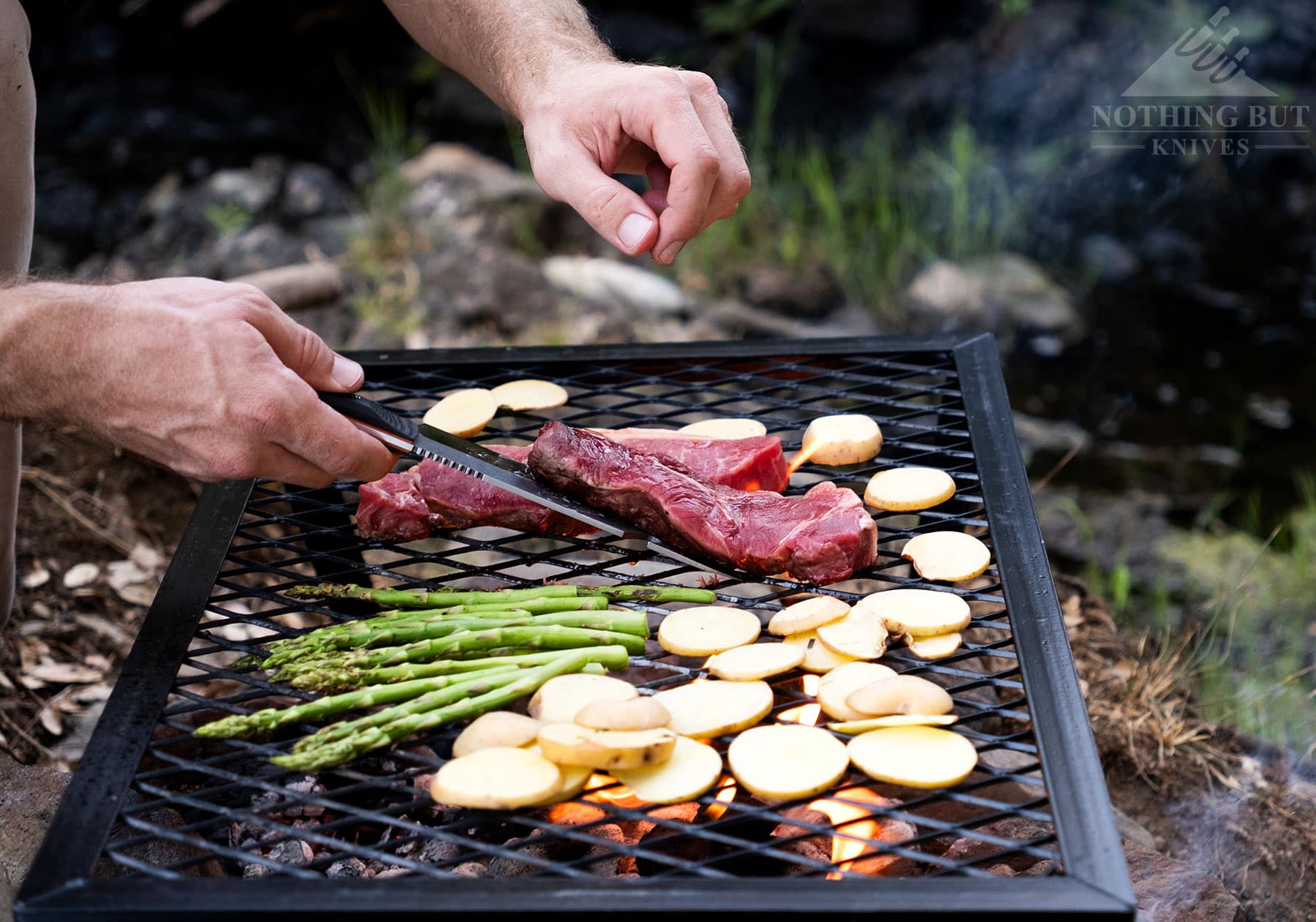
Let’s not overthink this. It cuts food and opens beers for less than $100.
As someone who uses knives, the Maxsa Blade is great.
As someone who reviews knives, it’s surprising. A lot of people are trying to make knives right now, and it’s become almost a red flag when they have a site that looks nice but doesn’t provide a lot of information. I genuinely didn’t think this was going to hold up to real use.
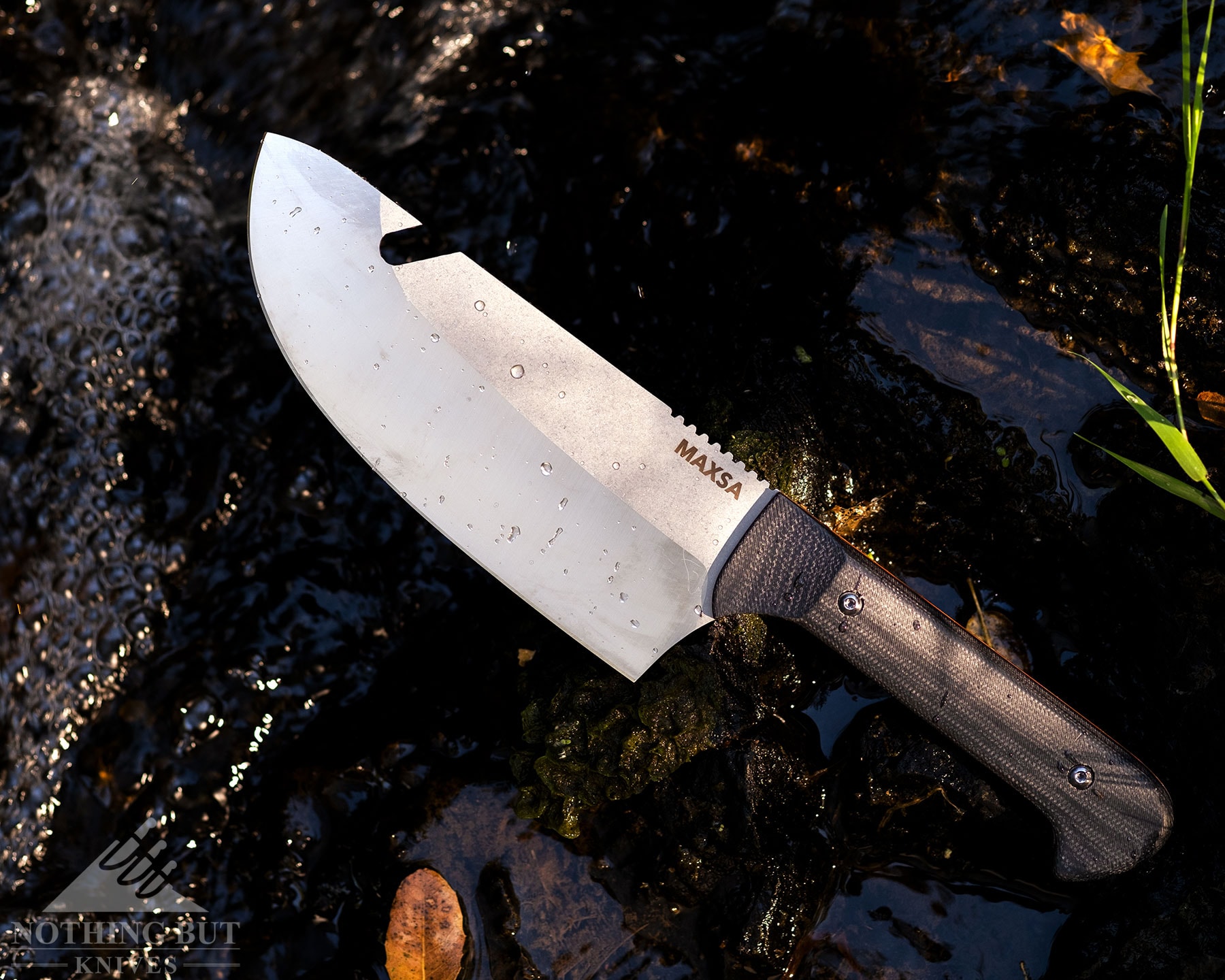
But I chopped wood and cooked over a campfire on repeat and the blade made it back home whole and still able to cut paper after a little bit of maintenance.
I wish they would go easy on the jimping and maybe do something with the sheath to make it wearable, but it easily passes the use-for-cost test, and it even passes the test where I sit back after a splitting a log and get some meat slabs cooking on a grill and say “you know what? This is actually pretty cool”.

Love the write up Andrew! I got one and have been thoroughly enjoying its versatility. Thank you!
It’s a handy beast to have for sure. Thanks for reading.